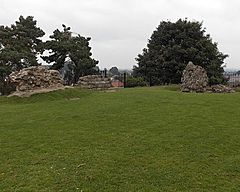Battle of Oswestry facts for kids
Quick facts for kids Battle of Oswestry |
|||||||
|---|---|---|---|---|---|---|---|
| Part of the First English Civil War | |||||||
 Remains of Oswestry Castle |
|||||||
|
|||||||
| Belligerents | |||||||
| Commanders and leaders | |||||||
| Edward Lloyd | Lord Denbigh Thomas Mytton |
||||||
| Strength | |||||||
| Unknown | 200 foot | ||||||
The Battle of Oswestry was an important fight during the First English Civil War. It happened on June 22-23, 1644, in Oswestry, Shropshire. In this battle, soldiers loyal to Parliament (called Parliamentarians) attacked and took control of the town from soldiers loyal to King Charles I (called Royalists). The Parliamentarian forces were led by Lord Denbigh.
Why the Battle Happened
In early 1644, Prince Rupert, a key Royalist leader, moved to Wales. He became the President of Wales. However, in May, he took most of his soldiers and marched to Lancashire. This left Oswestry with only a small group of Royalist soldiers. Colonel Edward Lloyd was in charge of them.
At this time, the Royalists in Oswestry were important for controlling Wales and the areas around it, known as the Marches. With Prince Rupert away, the local Parliamentarian leaders saw a chance. Lord Denbigh and Colonel Thomas Mytton decided to attack Oswestry. They wanted to take control of the walled town and its castle in June 1644.
What Happened During the Battle
The attack on Oswestry started at 2 PM on June 22. The Parliamentarians had learned from spies that the town was not fully defended. This was because the Royalist Governor had taken some Parliamentarian prisoners to Shrewsbury.
Parliamentarian cavalry (soldiers on horseback) were placed behind the main attacking force. Their job was to stop any Royalist help from arriving. Meanwhile, 200 foot soldiers (infantry) moved forward to attack the town.
First, the Parliamentarians captured St Oswald's church. This church was defended but stood outside the town walls. After taking the church, they used cannons to break down the main gate of the town. The Royalist defenders then pulled back into Oswestry Castle. The Parliamentarians quickly took control of the town itself.
The next morning, the Royalist soldiers inside the castle were convinced to give up. After the surrender, Lord Denbigh left Colonel Mytton in charge of the town. Lord Denbigh then went off to chase Prince Rupert.
What Happened After the Battle
Losing Oswestry was a big problem for the Royalists. It cut off the way to communicate between their forces in Chester and Shrewsbury. Because of this, Sir Fulke Huncke, the Royalist commander in Shrewsbury, felt he had to get Oswestry back. He set out with 2,000 infantry and 600 cavalry to try and retake the town.
Lord Denbigh, who had reached Cheshire by this time, sent Sir Thomas Myddelton back. Myddelton brought cavalry to help the Parliamentarian defenders in Oswestry. Colonel Marrow led the Royalist cavalry to stop Myddelton's force. However, on July 2, the Parliamentarian cavalry defeated Marrow's forces at Whittington. This place was about three miles from Oswestry.
Because he had lost his cavalry, Huncke was forced to go back to Shrewsbury. The Royalists could not retake Oswestry. Later, by 1650, the Parliamentarians destroyed Oswestry Castle.

